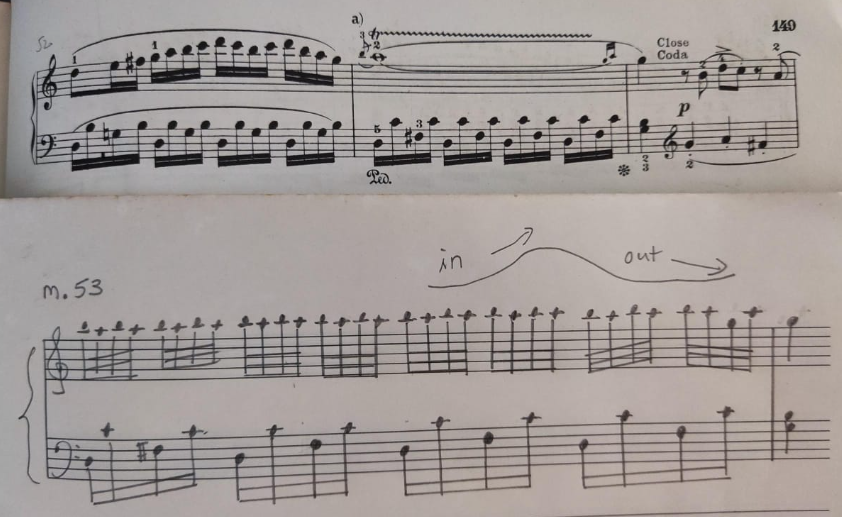Week 2 Assignment
Week 2 assignment:
There are two options this week
- Record a video of yourself playing a trill you are struggling with. It does not matter how many mistakes there are. This is a comparison video.
- After a week of using the practice methods discussed, make a new video of the same passage, acknowledging that a week is a very short amount of time and perfection is not expected.
- You can post a side-by-side video showing your progress.... please include your comments on what you experienced and which methods you found most effective and why you believe that is the case.
Option 2
- Record a brief practice session of your trill, demonstrating your incorporation of methods discussed. Your video will be reviewed and discussed, explaining what elements of the practice are working and which may need further clarification. This is a very helpful option if you would like more specific individualized feedback on what you are doing with your technique. This will also help your other friends, who may also be struggling, somewhat like mini-masterclasses.
https://youtu.be/ymH0eWQTTWw?si=2Ioi8t7pcYFbNyaF
35 replies
-
Leann, I appreciate your detail-oriented video on how to practice trills. Here’s a brief clip of a session practicing the trills in the coda of Paderewski’s Menuet in G major.
Paderewski Minuet in G major Coda
https://youtube.com/shorts/PN4cVf_MoXA?feature=share -
Thanks Leann for the very detailed demonstration. Below is a clip of me practicing a trill following your suggested approach. I am concentrating on not using my fingers, staying on the key and allowing the key to pop up. It frequently doesn’t so I have missed notes.
-
Hi all! I’m a little behind on getting started on this challenge but I still struggle with this long trill section of Chopin’s Nocturn Op.72 No.1 - the section in the blue brackets. Here is my first recording of me playing it kind of slow but when I play faster they just aren’t as clearly articulated as I would like. I’m looking forward to applying what I learn here from Leann ❤️
-
Hi Dr Leann,
Here's my practice for a short trill (m. 65) and a long trill (m. 53) on the Mozart sonata K309.
The short trill (as I posted in week1 assignment) - I tried practising with your suggestion of a quick triplet, then only the F#-G.
The long trill - my usual struggle is RH and LH not very coordinated after it has started off. In this video, I tried practicing with the in-out-in-out of the fingerings 2-3 as you mentioned in the week2 video. Can you please check if I am doing correctly ?
Usually I would practice slowly LH & RH together to make sure they are in sync.
More recently I tried the grouping of 1-2, then 3-4-1-2, 3-4-1-2 together with the LH 16th note.
But I noticed if I use the fingerings 1-3, with some rotation, it seems easier (the last bit on my video).
https://youtube.com/shorts/nn2jecu2uAY?si=8dYKG1XnQAtsCEwG
Thanks so much again for your guidance :)
-
So here are the two trills I wrote out last week from the Chopin Nocturne in c# minor
-
Hi Dr Leann,
I'm working on the Beethoven sonata op 111. I've been struggling with the trills on the last pages of the second movement. I'm essentially doing the suggestion of von Bulow and Lamond of playing two notes of the trill in the right hand per note in the left hand like the image except I'm starting the t. When the melody is an octave apart from the trill, I drop the trill for one left hand note and then pick it back up on the principal note the G. Here a small video of me practicing the last two pages with the trill. Do you have any advice for me or advice in general on practicing a trill with a melody note either on the top played with the pinky or on the bottom played with the thumb? Thank you so much for you videos. They've been helpful and I started to incorporate some of the strategies you mentioned.
https://www.youtube.com/shorts/_Y0j41ErUfM
Javier -
Here is my BEFORE video of the B Major Prelude from Book 2 of the WTC. 2 difficult LH trills right in the opening 2-3 measures. Can spoil the whole performance if messed up at the beginning. I have these trills all mapped out as far as the number of notes etc., but It is evident here that I have trouble playing them at an even moderately fast tempo. I'm practicing with the techniques discussed in the Week 2 video, and hopefully I'll be able to post an AFTER video showing some improvement! I know that I tend to overplay with my fingers and find this concept of a rotation or "shake" of the forearm difficult to implement, but your video lesson was very informative and helpful.
The trills appear at:
mm. 1 & 2 [0:03-0:12]
m: 25 [1:18] (with 3& 5 trilling while 1 is held down -- challenging!)
mm: 37-38 [1:47-1:51]
thanks for a great workshop! I too am learning a lot from your comments on the other participants' videos.

